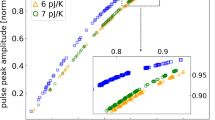Abstract
High-energy-resolution X-ray spectroscopy using X-ray microcalorimeters has been widely adopted for high-precision experiments on fundamental science. The technical difficulties come from its use at low temperatures and its high sensitivity to the external environment, though many countermeasures have been proposed through the experience of space applications. The limit of the number of pixels of the semiconductor-type X-ray microcalorimeters can be solved by using the transition-edge sensor (TES) superconducting detector. Recently, a study of the strong nuclear force via high-energy-resolution X-ray spectroscopy of kaonic atoms using TES at the J-PARC accelerator facility was successfully performed by the HEATES collaboration. Furthermore, muonic-atom spectroscopy using TES has been demonstrated at the J-PARC muon facility, and a physical experiment to test the electromagnetic force under a strong electric field is ready for commissioning. Material diagnostics at a hard X-ray synchrotron facility have been tested at SPring-8 and resulted in a successful operation for the first time. Other than X-rays, TES has been used as a mass spectrometer for neutral molecules in a cryogenic electrostatic ion ring. The entire design of the experiment is carefully considered to meet the science-specific requirement. We will summarize the latest and future applications of the microcalorimeter and present key technologies, such as digital electronics, data acquisition software, aperture, collimator, mechanical, and electrical interface. Our results will be helpful for other users to design new experiments for fundamental science.



Similar content being viewed by others
References
W.B. Doriese et al., Rev. Sci. Instrum. 88, 053108 (2017)
S. Okada, HEATES Collaboration et al., Prog. Theor. Exp. Phys. 2016(9), 091D01 (2016). https://academic.oup.com/ptep/article/2016/9/091D01/2590795
Hitomi Collaboration, Nature 535, 117–121 (2016)
XRISM Collaboration, SPIE, Ultraviolet to Gamma Ray, 10699 (2018)
S. Yamada et al., J. Low Temp. Phys. 184(3), 688–693 (2016)
H. Tatsuno, HEATES Collaboration et al., J. Low Temp. Phys. 184, 930–937 (2016). https://link.springer.com/article/10.1007%2Fs10909-016-1491-2
T. Hashimoto, HEATES Collaboration et al., IEEE Trans. Appl. Supercond. 27, 4 (2017)
R.L. Kelley et al., Proc. SPIE 9905, 99050V (2016)
J.N. Ullom, D.A. Bennett, Supercond. Sci. Technol. 28, 084003 (2015)
C.D. Reintsema, J. Beyer, S.W. Nam, S. Deiker, G.C. Hilton, K.D. Irwin, J. Martinis, J.N. Ullom, L.R. Vale, Rev. Sci. Instrum. 74, 4500 (2003). https://doi.org/10.1063/1.1605259
S. Yamada et al., J. Low Temp. Phys., this Special Issue LTD18 (2020)
R. Hayakawa et al., J. Low Temp. Phys., this Special Issue LTD18 (2020)
H. Tatsuno et al., J. Low Temp. Phys., this Special Issue LTD18 (2020)
T. Hashimoto et al., J. Low Temp. Phys., this Special Issue LTD18 (2020)
G. Yoshida, K. Ninomiya, T.U. Ito, W. Higemoto, T. Nagatomo, P. Strasser, N. Kawamura, K. Shimomura, Y. Miyake, T. Miura, K.M. Kubo, A. Shinohara, J. Radioanal. Nucl. Chem. 303, 1277 (2015)
S. Okada et al., J. Low Temp. Phys., this Special Issue LTD18 (2020)
K. Terada et al., Sci. Rep. 7, 15478 (2017). https://www.nature.com/articles/s41598-017-15719-5
Y. Nakano et al., Rev. Sci. Instrum. 88, 033110 (2017)
Y. Nakano, R. Igosawa, S. Iida, S. Okada, M. Lindly, S. Menk, R. Nagaoka,T. Hashimoto, S. Yamada, T. Yamaguchi, S. Kuma, T. Azuma, in JPS Conference Proceedings (2018)
M. Wada et al., Nucl. Instrum. Methods Phys. Res. B204, 570–581 (2003)
Y. Yano, Nucl. Instrum. Methods Phys. Res. Sect. B: Beam Interact. Mater. At. 261(1–2), 1009–1013 (2007)
M. Tanabashi, Particle Data Group et al., Phys. Rev. D 98, 030001 (2018)
SIDDHARTA Collaboration, M. Bazzi et al., Phys. Lett. B 704, 113 (2011)
Y. Ishisaki et al., Proc. SPIE 9905, 99053T (2016)
Y. Takei et al., Proc. SPIE 9905, 99050X (2016)
Y. Ichinohe, S. Yamada, MNRAS 487, 2 (2019)
T. Brand, J. Wilms, T. Dauser, P. Peille et al., Observing the WHIM with Athena, in Proceedings on SPIE 9905, these proceedings (2016)
A. G. Jessica et al., SPIE 10397, UV (2017)
Acknowledgements
This work was supported by JSPS KAKENHI Grant Nos. 16H02190, 15H05438, 18H03714, and 18H05458. We appreciate the significant contribution made by NIST, J-PARC, RIKEN, HEATES Project, ASTRO-H/XRISM/DIOS Project, JASRI, and SPring-8.
Author information
Authors and Affiliations
Corresponding author
Additional information
Publisher's Note
Springer Nature remains neutral with regard to jurisdictional claims in published maps and institutional affiliations.
Rights and permissions
About this article
Cite this article
Yamada, S., Tatsuno, H., Okada, S. et al. Coevolution of the Technology on Transition-Edge-Sensor Spectrometer and Its Application to Fundamental Science. J Low Temp Phys 200, 418–427 (2020). https://doi.org/10.1007/s10909-020-02441-2
Received:
Accepted:
Published:
Issue Date:
DOI: https://doi.org/10.1007/s10909-020-02441-2




